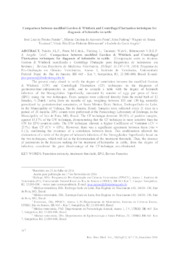Comparison between modified Gordon & Whitlock and Centrifugal Fluctuation techniques for diagnosis of helminths in cattle.
Comparison between modified Gordon & Whitlock and Centrifugal Fluctuation techniques for diagnosis of helminths in cattle.
Autoria: PAIXÃO, J. L. de F.; PRATA, M. C. de A.; FURLONG, J.; TASSINARI, W. de S.; BITTENCOURT, V. R. E. P.; ANGELO, I. da C.
Resumo: The present study aimed to verify the degree of correlation between the modified Gordon & Whitlock (GW) and Centrifugal Fluctuation (CF) techniques in the diagnosis of gastrointestinal endoparasites in cattle, and to compile a table with the degree of helminth infection of the Strongyloidea Superfamily, measured by number of eggs per gram of feces (EPG) using the two techniques. Feces samples were collected directly from the rectal bulb of 12 females, ¾ Dutch / zebu, from six months of age, weighing between 100 and 150 kg, naturally parasitized by gastrointestinal nematodes, at Santa Mônica Dairy Station, Embrapa/Gado de Leite, in the Municipality of Valença, Rio de Janeiro, Brazil. Samples were collected every 21 days in a period of 28 months. EPG counts were performed at the Parasitology Laboratory of Embrapa, in the Municipality of Juiz de Fora, MG, Brasil. The CF technique detected 80.81% of positive samples, against 15.17% of the GW technique, demonstrating that the CF technique is more sensitive than the GW for EPG count in cattle. The GW technique showed a higher Coefficient of Variation (CV = 237%) than CF (CV = 68%). However, there was a significant agreement between them (rho = 0.12), confirming the existence of a correlation between them. This confirmation allowed the elaboration of a table of the degree of helminth infection of the Strongyloidea Superfamily based on the two techniques, which will aid in the determination of the treatment threshold. Thus, the absence of parameters in the decision making for the treatment of helminths in cattle, from the degree of infection, considered the great disadvantage of the CF technique, was eliminated.
Ano de publicação: 2016
Tipo de publicação: Artigo de periódico
Unidade: Embrapa Gado de Leite
Palavras-chave: Bovine, EPG, Parasitism intensity, Treatment threshold, parasites
Observações
1 - Por padrão são exibidas publicações dos últimos 20 anos. Para encontrar publicações mais antigas, configure o filtro ano de publicação, colocando o ano a partir do qual você deseja encontrar publicações. O filtro está na coluna da esquerda na busca acima.
2 - Para ler algumas publicações da Embrapa (apenas as que estão em formato ePub), é necessário ter, no celular ou computador, um desses softwares gratuitos. Sistemas Android: Google Play Livros; IOS: iBooks; Windows e Linux: software Calibre.
Acesse outras publicações
Acesse a Base de Dados da Pesquisa Agropecuária (BDPA) para consultar o acervo completo das bibliotecas da Embrapa.

